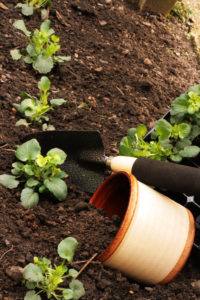How to Prepare a Garden for a Fall Harvest
 Do you typically just plant all of your veggies and herbs at one time in the Spring? If not, how many crops do you get out of the exact same garden bed space? Did you know that even in the Northeast United States you can get up to 5 harvests from the same space?
Do you typically just plant all of your veggies and herbs at one time in the Spring? If not, how many crops do you get out of the exact same garden bed space? Did you know that even in the Northeast United States you can get up to 5 harvests from the same space?
By utilizing succession planting, a method used to increase the harvest in the same growing space, you can grow more vegetables without having a larger vegetable garden.
This means you can harvest more from the same garden bed by continuing to plant your garden throughout the season, not just in the Spring.
Even if you haven’t already replanted your garden a few times this season, you still have time to take advantage of a fall harvest if you act fast. Planting for a fall harvest is typically done in late Summer…around mid to late August.
Here’s how to prepare and plant the vegetable garden for a fall harvest:
- First, you need to have, or be able to create, some open garden bed space. This can be space once occupied by Spring greens, or maybe space occupied by a squash or cucumber plant that is on it’s last leg.
- Next, lightly amend the soil with either a little compost or an organic fertilizer. Mix this is in to the top inch or two of garden soil.
- Now the garden is ready and you just need to decide on what you would like to plant. Unfortunately most nurseries do not supply much in terms of starter plants for a fall harvest. You may be able to find some cabbage, broccoli, and cauliflower starter plants, but most likely you will need to plant seeds of anything you would like to grow. The most important things to consider are the days to maturity and your first fall frost date. You need to make sure that the crops your planting will actually have time to reach maturity. The number of days listed on the seed pack indicates the time under ideal growing conditions, when the daylight is the longest in the summer. I recommend adding 7-10 extra days to the number listed on the seed pack when planting later in the season. In the late summer and early fall, the day length is less than the ideal conditions and therefore the plants need a little more time to develop. This is also true of early Spring plantings.
I always favor varieties with the shortest number of days to maturity so keep that in mind when comparing seed packs of the same crop. For example, some radishes can mature in 20 days, some in 30. I would choose the radishes that can mature from seed to harvest in 20 days hands down usually but you can actually take advantage of this inherent difference. Instead of staggering the planting of the same variety 10 number of days apart, you could plant seeds of each of these varieties on the same day and naturally have a staggered harvest. You could do the same for different varieties of carrots and possibly other crops as well.
Good choices for fall crops include leaf lettuces, arugula, mustard greens, carrots, radishes, beets, chinese cabbage, kale, spinach and turnips. All of these are quick to mature and also frost tolerant without any protection. Proper seed spacing is important for any root crops so that there is space for the crop to develop. 2-3 inches is perfect for carrots and radishes, and 3-4 inches is great for beets and turnips. As for the leaf lettuces, arugula, mustard greens, tatsoi, and spinach I like to seed these densely so that I can take a handful greens with one hand and use a knife or scissors to harvest down to about an inch from the soil. The greens will regrow in about 10 days and I can repeat the harvest.
- Be sure to place a little plant marker in the soil to indicate the crop, variety, date planted, and I also like to include the number of days to maturity so I know when to expect a harvest.
- Once your seeds are planted, you will want to gently hand water for about a week until the seeds germinate. Then, you can continue with your routine system of watering, whether that be a soaker or drip hose, watering by hand or overhead sprinkler.
I hope you are able to benefit from this information and use it to maximize your harvest from your vegetable garden.
Happy Gardening!



